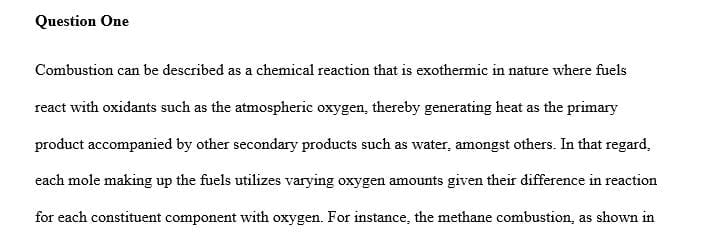Combustion drives many energy systems from process heating to vehicles to many power plants.
Combustion drives many energy systems from process heating to vehicles to many power plants.
You will have had assignments related to combustion: fuels and fuel composition, simple combustion and chemical reactions, and chemical equilibrium. We discussed chemical kinetics, but the sophistication of the many coupled differential equations required, led to a simplified discussion. The methods up to kinetics deal with composition outcomes, but tell us nothing about the actual rate process to get there. Thus, time effects and intermediate reactions are missing. The entire topic of pollutants becomes simply a postulation of “what if” outcomes without a knowledge of fast reacting intermediates that lead to those outcomes. So this assignment is to write a paper (approximately 2 pages, based on class presentations, the course postings, your text and thermodynamics text, and any online sources) with the following outline:
I. Fuels – why does chemical composition play a role in combustion (include C, H, O, N, & S). Talk about how carbon and sulfer content have changed fuels, like coal and diesel, in recent years.
II. Simple Chemical Combustion – why do differing amounts of air and inlet conditions play a role in the overall result of combustion. Key results were the heat liberated by combustion and the maximum temperature of combustion, discuss this trade-off briefly.
III. Chemical Equilibrium gives us a snapshot of the possible interactions of potential chemical interaction of reacted or of partially reacted components of chemical. Many of our HW problems were hypothetical or postulated results, which (if known) give us insight into possibilities – discuss how knowing this helps us to know which reactions are most important and how this relates to utilization of fuel in combustion or assessing hypothetical pollutants at a snap shot in time.
IV. Chemical Kinetics gives us perhaps hundreds of reactions, many of which are very short timeframe, but the ultimate outcome may be said to be the same as II above. Similarly, the main polluting components, NOx and SOx, may be said to have an ultimate outcome. Above, we said time is a factor, in controlling pollution, why might this be so (in terms of energy conversion rate)?
V. There has been considerable discussion on nitrogen oxides (NOx) as a pollutant re VW. Clearly, combustion with hot enough air has NOx as a product. Obviously, high compression ratio makes a desirable performance situation, but can lead to more NOx. Discuss how 2 basic cycles (Otto and Diesel), might lead to a particular outcome. Pick a single model of of automobile that offers both offers both (lowest cost option), to compare, rate in terms of NOx.
You may attach materials beyond the 2 pages as backup, but the narrative should not be much more than that. Your grade will be directly related to your ability to synthesize the information covered in the course and any additional readings. Each subtopic above will count from 0-15 points. 25 points will count toward overall synthesis of the topic.
Solution preview for the order on combustion drives many energy systems from process heating to vehicles to many power plants.
APA
694 words
